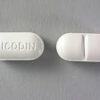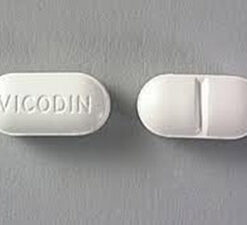Vicodine for pain relief
$360.00 – $1,400.00Price range: $360.00 through $1,400.00
Are you looking to Buy Oxycodone Online? If so,Vital Life Suppliers is the perfect choice for you! Shop with us today and get your Oxycodone delivered quickly!
Buy Vicodine for pain relief
buy Vicodine for pain relief is a prescription medication commonly used for the relief of moderate to severe pain. It combines hydrocodone, an opioid analgesic, with acetaminophen, a pain reliever. This powerful combination works to alleviate pain and is typically prescribed for conditions such as post-surgery recovery, injury-related pain, or chronic conditions requiring short-term pain management. It helps reduce discomfort while ensuring a faster recovery time.
Important Usage Information: it should only be taken under a doctor’s supervision due to the risk of addiction and side effects. Always follow your healthcare provider’s guidance when using this medication.
Features & Benefits:
- Effective relief from moderate to severe pain
- Combines hydrocodone and acetaminophen for enhanced effectiveness
- Provides fast-acting relief to improve comfort
- Available in convenient pill form for ease of use
Common Uses:
- Pain relief after surgery
- Injury-related pain
- Chronic pain management (under strict medical supervision)
Precautions:
- May cause drowsiness or dizziness
- Risk of addiction if used improperly
- Do not exceed the prescribed dosage
Vicodin is a prescription medication that combines two active ingredients: hydrocodone and acetaminophen. It is primarily used to relieve moderate to severe pain. Hydrocodone is an opioid analgesic that works by altering the way the brain and nervous system respond to pain, while acetaminophen is a non-opioid pain reliever that helps increase the pain-relieving effects of hydrocodone.
Vicodin is typically prescribed for conditions like post-surgical pain, injury-related pain, or chronic pain when other pain management options are insufficient. However, it is important to use Vicodin only as prescribed due to the potential for dependence, abuse, and side effects such as drowsiness, dizziness, nausea, or constipation. Vicodin should not be used with alcohol or other substances that depress the central nervous system, as it can increase the risk of severe side effects.
Certainly! Here’s a more detailed description of Vicodin:
Composition and Mechanism of Action:
- Hydrocodone: This is an opioid analgesic, meaning it’s a narcotic pain reliever. Hydrocodone works by binding to opioid receptors in the brain and spinal cord, which helps to block the transmission of pain signals. It also has cough-suppressing properties, which is why it’s sometimes included in combination products for treating coughs.
- Acetaminophen: A non-opioid pain reliever, acetaminophen works by inhibiting certain chemicals in the brain (prostaglandins) that cause pain and inflammation. It enhances the analgesic effect of hydrocodone, making it more effective for relieving pain.
Uses:
Vicodin is commonly prescribed to manage:
- Acute pain: Such as post-surgery pain, injury-related pain (e.g., fractures, sprains), or dental procedures.
- Chronic pain: For individuals dealing with long-term pain conditions, though it’s typically used when other pain management strategies have proven insufficient.
- Cough suppression: When combined with other medications, hydrocodone can help control severe coughing (though this is less common in combination with acetaminophen).
Dosage:
The usual starting dosage depends on the individual’s condition and response to the drug. Vicodin is available in various strengths, typically ranging from:
- Hydrocodone 5 mg with acetaminophen 300 mg
- Hydrocodone 7.5 mg with acetaminophen 300 mg
- Hydrocodone 10 mg with acetaminophen 300 mg
The recommended dosing frequency is generally every 4 to 6 hours, but the specific regimen depends on the doctor’s recommendation.
Side Effects:
While Vicodin is effective at managing pain, it can have several side effects, which may vary depending on the person’s health condition and dosage:
- Common side effects:
- Drowsiness
- Dizziness
- Nausea and vomiting
- Constipation
- Lightheadedness
- Headache
- Serious side effects:
- Respiratory depression (slowed breathing), which can be life-threatening, especially in higher doses or if taken with other CNS depressants like alcohol.
- Liver damage (due to acetaminophen, especially if taken in high doses or combined with alcohol).
- Addiction or dependency (due to hydrocodone’s opioid nature).
- Severe allergic reactions (rash, itching, swelling, trouble breathing).
Precautions and Warnings:
- Dependence and Abuse: Since hydrocodone is an opioid, there is a risk of developing tolerance, physical dependence, and even addiction. Long-term use of Vicodin should be carefully monitored by a healthcare provider.
- Liver Damage: Acetaminophen can be toxic to the liver, particularly when taken in large doses or with alcohol. Therefore, it’s critical not to exceed the prescribed dosage.
- Interactions: Vicodin can interact with various medications, including other CNS depressants (such as benzodiazepines, alcohol, or other opioids), which could increase the risk of severe side effects. It also interacts with certain antidepressants, anti fungal medications, and medications that affect liver enzymes.
- Pregnancy and breastfeeding: Vicodin is generally not recommended during pregnancy, especially in the later stages, due to the risk of opioid dependency in the newborn. It can also pass into breast milk and may affect a nursing baby. buy Vicodine for pain relief
Withdrawal Symptoms:
If someone has been taking Vicodin for a prolonged period, suddenly stopping it can lead to withdrawal symptoms, which include:
- Anxiety or agitation
- Sweating
- Muscle pain or stiffness
- Insomnia
- Vomiting or diarrhea
- Increased heart rate and blood pressure. buy Vicodine for pain relief
Summary:
While Vicodin is effective in managing pain, its opioid component (hydrocodone) carries risks related to dependence, overdose, and side effects. It’s important for patients to follow their doctor’s instructions carefully, use the medication only for short-term pain relief if possible, and never exceed the prescribed dose. If you or someone you know is struggling with Vicodin use, it’s important to seek professional help to prevent misuse and dependence.
| Vicodine | 60 PILLS, 100 PILLS, 150 PILLS, 200 PILLS, 250 PILLS, 300 PILLS |
|---|
Be the first to review “Vicodine for pain relief” Cancel reply
Related products
Buy Vicodin Online




Reviews
There are no reviews yet.